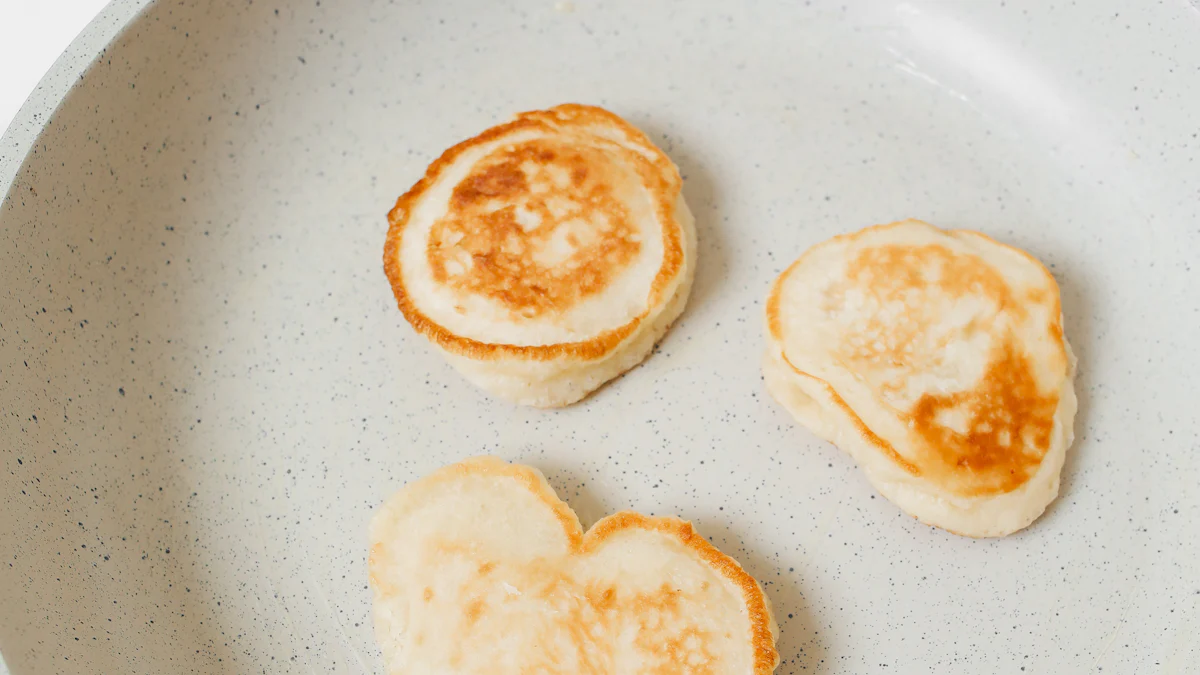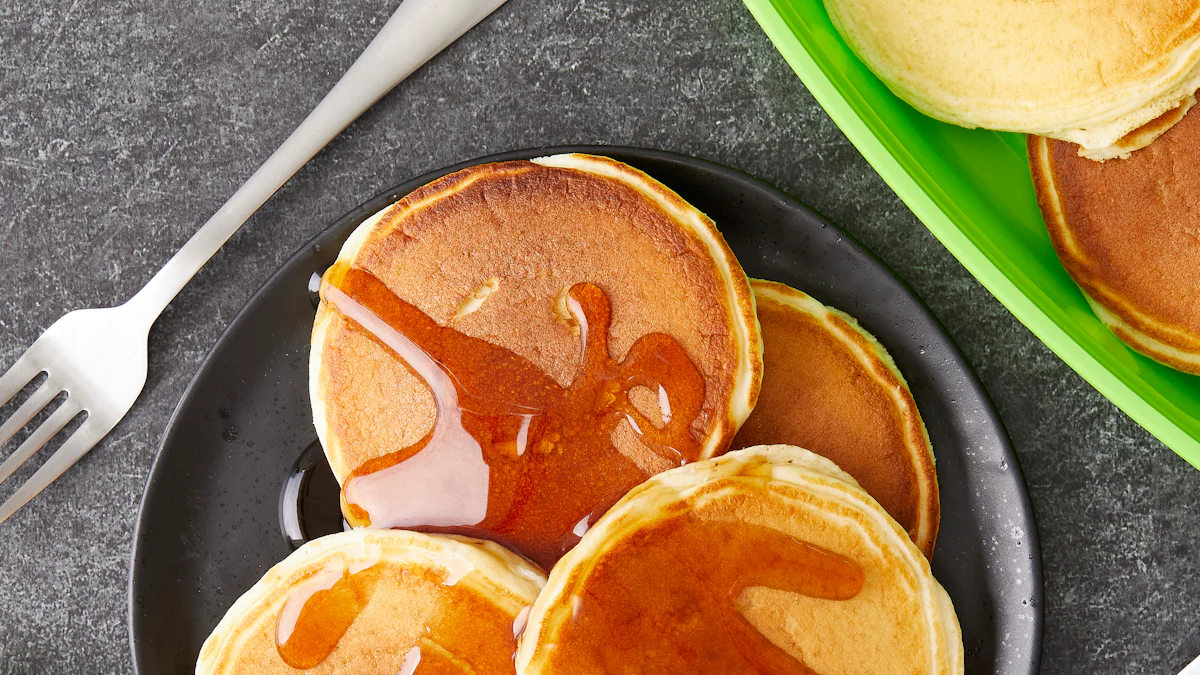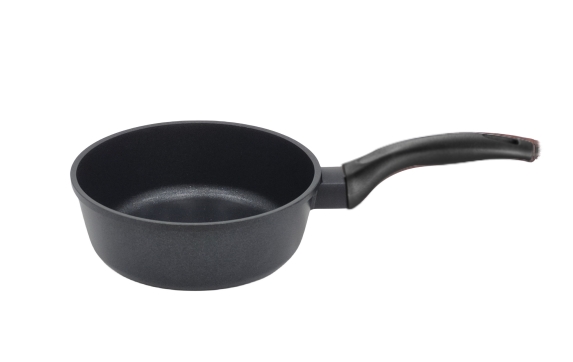
Nonstick pans simplify pancake preparation by preventing batter from sticking and ensuring even cooking. Their smooth surface allows pancakes to glide effortlessly, making them ideal for beginners. An Aluminum Non stick Pancake Pan offers convenience and precision, helping cooks achieve golden-brown pancakes with minimal effort. These pans enhance the overall cooking experience.
Key Takeaways
- Nonstick pans help pancakes not stick, making flipping simple.
- You can use less oil or butter, keeping pancakes tasty.
- Cleaning nonstick pans is fast and easy, saving time daily.
Benefits of Using Nonstick Pans for Pancakes
ng with no sticking
Nonstick pans excel at preventing batter from adhering to the surface. This feature ensures that pancakes can be flipped effortlessly without tearing or breaking. The smooth surface of an Aluminum Non stick Pancake Pan allows even delicate pancakes to retain their shape. This makes it easier to achieve a professional-looking stack every time. The nonstick coating eliminates the frustration of scraping stuck batter, saving time and effort during cooking.
Reduced need for oil or butter
Nonstick pans require minimal oil or butter to prevent sticking. This makes them an excellent choice for those seeking healthier cooking options. An Aluminum Non stick Pancake Pan provides a surface that allows pancakes to cook evenly without excessive greasing. This not only reduces calorie intake but also preserves the natural flavor of the pancakes. The reduced use of fats also minimizes splattering, keeping the cooking area cleaner.
Easy cleanup after cooking
Cleaning a nonstick pan is remarkably simple. The nonstick coating prevents batter residue from hardening on the surface, allowing it to be wiped away with ease. An Aluminum Non stick Pancake Pan can often be cleaned with just warm water and a soft sponge. This convenience saves time and effort, making it a practical choice for busy mornings. Proper cleaning also helps maintain the pan’s coating, ensuring long-term usability.
Perfect for novice cooks
Nonstick pans are ideal for individuals new to cooking. Their forgiving surface reduces the likelihood of mistakes, such as burnt or stuck pancakes. An Aluminum Non stick Pancake Pan simplifies the process, enabling beginners to focus on mastering their technique. The even heat distribution ensures consistent results, boosting confidence in the kitchen. This reliability makes nonstick pans a valuable tool for anyone learning to cook.
Drawbacks of Nonstick Pans for Pancakes
Short lifespan of the nonstick coating
Nonstick pans often have a limited lifespan due to the gradual wear of their coating. Frequent use and cleaning can cause the surface to deteriorate over time. This wear reduces the pan’s effectiveness, leading to sticking issues. Users may find themselves replacing nonstick pans more frequently compared to other cookware options. Proper care, such as avoiding abrasive cleaning tools, can help extend the lifespan, but the coating’s eventual degradation remains inevitable.
Health concerns with certain materials
Some nonstick coatings, particularly older or lower-quality ones, may contain materials that raise health concerns. For example, coatings made with perfluorooctanoic acid (PFOA) have been linked to potential health risks. Although most modern nonstick pans are now PFOA-free, consumers should verify the materials used in their cookware. Choosing reputable brands and checking product labels can help ensure safer cooking practices.
Unsuitable for high-heat cooking
Nonstick pans perform poorly under high temperatures. Excessive heat can damage the coating, causing it to release harmful fumes. Pancakes typically require medium heat, making nonstick pans suitable for this purpose. However, cooks who frequently use high-heat techniques may find these pans less versatile. Maintaining moderate temperatures is essential to preserve the pan’s integrity and ensure safe cooking.
Requires gentle handling to avoid damage
Nonstick pans demand careful handling to maintain their coating. Metal utensils, abrasive sponges, or stacking pans without protection can scratch the surface. These scratches compromise the nonstick properties, reducing the pan’s performance. Silicone or wooden utensils and soft cleaning tools are recommended to prevent damage. While these precautions are manageable, they may require extra attention from users.
Note: Proper care and mindful usage can mitigate many of these drawbacks, ensuring a longer lifespan and better performance for nonstick pans.
Tips for Making Perfect Pancakes with an Aluminum Non stick Pancake Pan

Preheat the pan for even cooking
Preheating ensures the pan reaches an optimal temperature before the batter is added. An Aluminum Non stick Pancake Pan distributes heat evenly, preventing hot spots that can cause uneven cooking. Allow the pan to warm over medium heat for a few minutes. To test readiness, sprinkle a few drops of water onto the surface. If the water sizzles and evaporates quickly, the pan is ready for use.
Lightly grease the pan for better results
Although nonstick pans require minimal greasing, a small amount of oil or butter enhances the flavor and texture of pancakes. Use a paper towel or silicone brush to spread a thin, even layer across the surface of the Aluminum Non stick Pancake Pan. This step ensures the batter cooks smoothly without sticking, while also creating a golden-brown finish.
Pour batter evenly for uniform pancakes
Consistency in batter distribution is key to achieving pancakes of the same size and thickness. Use a ladle or measuring cup to pour the batter into the pan. For an Aluminum Non stick Pancake Pan, aim to pour the batter at the center and allow it to spread naturally. This technique ensures uniform cooking and a visually appealing stack.
Flip pancakes at the right moment
Timing is crucial when flipping pancakes. Wait until bubbles form on the surface and the edges appear set before flipping. Use a silicone or wooden spatula to gently lift and turn the pancake. The smooth surface of an Aluminum Non stick Pancake Pan makes flipping effortless, reducing the risk of tearing or breaking.
Clean the pan carefully to maintain its coating
Proper cleaning preserves the nonstick coating and extends the pan’s lifespan. Allow the Aluminum Non stick Pancake Pan to cool before washing. Use warm water, mild dish soap, and a soft sponge to remove residue. Avoid abrasive scrubbers or harsh detergents, as these can damage the coating. Dry the pan thoroughly before storing to prevent moisture buildup.
Pro Tip: Always follow the manufacturer’s care instructions to maximize the performance and durability of your Aluminum Non stick Pancake Pan.
Alternatives to Nonstick Pans for Pancakes
Cast iron pans for superior heat retention
Cast iron pans excel in heat retention, making them a reliable choice for cooking pancakes. Their heavy construction ensures even heat distribution, which helps achieve consistent browning. Once preheated, a cast iron pan maintains its temperature, allowing pancakes to cook evenly without frequent adjustments. This feature is particularly useful for preparing multiple batches. Proper seasoning of the pan creates a natural nonstick surface, enhancing the cooking experience. With proper care, cast iron pans can last for decades, offering durability unmatched by most other cookware.
Stainless steel pans for a crispier texture
Stainless steel pans provide a unique advantage for those who prefer pancakes with a slightly crisp edge. Their uncoated surface allows for a higher cooking temperature, which can create a golden, caramelized exterior. While stainless steel requires a bit more oil or butter to prevent sticking, it rewards cooks with a rich flavor and texture. These pans are also highly durable and resistant to scratches, making them a long-term investment for any kitchen. Mastering the use of stainless steel pans may take practice, but the results can be well worth the effort.
Electric griddles for cooking multiple pancakes
Electric griddles offer a spacious cooking surface, making them ideal for preparing pancakes in large quantities. Their consistent temperature control ensures even cooking across the entire surface. This feature is particularly beneficial for families or gatherings where multiple pancakes are needed quickly. Many electric griddles come with nonstick coatings, simplifying the cooking and cleaning process. Their flat design also makes flipping pancakes easier, reducing the risk of tearing. For those who value efficiency and convenience, electric griddles provide an excellent alternative.
Ceramic-coated pans as a nonstick alternative
Ceramic-coated pans serve as an eco-friendly and non-toxic alternative to traditional nonstick pans. Their smooth surface prevents sticking without the use of synthetic chemicals, offering a safer option for health-conscious cooks. These pans heat evenly, ensuring pancakes cook to perfection without hot spots. Ceramic coatings are also highly resistant to scratches, making them more durable than some other nonstick options. With proper care, ceramic-coated pans can deliver excellent results while maintaining their sleek appearance over time.
Tip: Each alternative offers unique benefits. Choosing the right pan depends on individual cooking preferences and priorities, such as texture, quantity, or durability.
Nonstick pans, such as the Aluminum Non stick Pancake Pan, simplify pancake preparation with their user-friendly design. They suit beginners and casual cooks seeking convenience. Alternatives like cast iron or electric griddles cater to different preferences. Selecting the best pan depends on individual cooking priorities, whether ease of use or durability takes precedence.
FAQ
What is the best way to maintain a nonstick pan?
Wash the pan with warm water and mild soap. Use a soft sponge to avoid scratches. Avoid metal utensils and store it carefully to protect the coating.
Can nonstick pans be used on induction cooktops?
Not all nonstick pans are compatible with induction cooktops. Check the product label for compatibility. Aluminum Non stick Pancake Pans with induction bases work well on such surfaces.
How long does a nonstick pan typically last?
A nonstick pan usually lasts 3 to 5 years with proper care. Avoid overheating and abrasive cleaning tools to extend its lifespan and maintain performance.
Post time: Jan-24-2025

